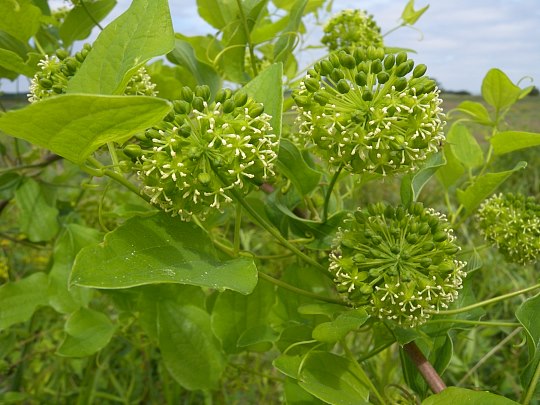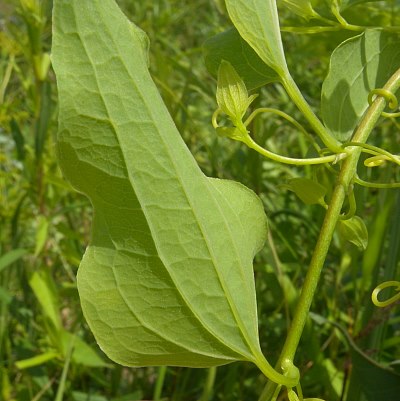Description: This climbing non-woody vine is a herbaceous perennial up to 8' long that branches occasionally. The light green to purple stems are terete, slightly speckled, glabrous, and often glaucous. Alternate leaves up to 3½" long and 2½" across occur at intervals along each stem; they are ovate-oval to broadly ovate-lanceolate in shape, smooth along their margins, and parallel-veined. The upper surfaces of the leaves are medium green and glabrous, while their lower surfaces are pale green and hairless. There are no hairs along the raised veins on the leaf undersides. The petioles of the leaves are up to 1¾" long, light green, and hairless. At the base of most petioles, there is a pair of tendrils that can cling to adjacent vegetation or objects for support. At the base of each stem on the vine, there is an appressed to slightly spreading sheath that is usually bladeless.

Individual umbels
of flowers are produced from the axils of the middle to upper leaves of
each mature vine. Each umbel is connected to the stem by a long stout
peduncle about 4-10" long. The peduncles are 4-8 times longer than the
petioles of adjacent leaves; they are similar in appearance to the
stems. Individual umbels are about 1½–3" across, consisting of 20-120
flowers on slender pedicels; when fully developed, they are globoid in
shape. Like other species in this genus, Smooth Carrion Flower is
dioecious; some vines produce only staminate (male) flowers, while
other vines produce only pistillate (female) flowers. The green to
yellowish green staminate flowers are individually about ¼" across,
consisting of 6 lanceolate tepals and 6 stamens with white anthers. The
green to yellowish green pistillate flowers are individually about ¼"
across, consisting of 6 lanceolate tepals and a pistil with 3 flattened
stigmata. The tepals of both kinds of flowers are often recurved. The
blooming period occurs from late spring to early summer and lasts about
3 weeks. The flowers often have a carrion-like scent, but its
presence
and strength varies with the local ecotype. Staminate flowers wither
away after blooming, while pistillate flowers are replaced by globoid
fleshy berries. Individual berries are about ¼" across and contain
about 3-5 seeds; they are dark blue and glaucous at maturity. At the
end of the growing season, the entire vine dies down to the ground.
Cultivation:
Smooth Carrion Flower prefers full or partial sun and more or less
mesic conditions. It flourishes in different kinds of soil, including
those that are rocky or loamy. In a shady situation, this vine may fail
to produce flowers.
Range & Habitat:
According to official records, Smooth Carrion Flower is rare in
Illinois. However, in neighboring states this vine has been found in
many counties and it is regarded as more common. It is possible that
some records of Smilax lasioneura (Common Carrion
Flower) in Illinois are based on misidentifications and it was Smooth
Carrion Flower that was observed. These two species are very similar in
appearance and easily confused. Habitats of the native Smooth Carrion
Flower
include savannas, thickets, prairies, rocky upland woodlands, woodland
openings, woodland borders, and fence rows. Occasional wildfires appear
to be beneficial in managing populations of this species.
Faunal Associations:
The flowers are pollinated primarily by small bees, miscellaneous
flies, and beetles. Fly visitors include Flesh flies, Blow flies,
Muscid flies, Syrphid flies, mosquitoes, and other species. The bees
suck nectar or collect pollen, while the flies and beetles suck nectar
or feed on pollen. The butterfly Megisto cymela
(Little Wood Satyr) has been observed sucking nectar from Carrion
Flower as well. Insects that feed on the foliage of Smilax
spp. (whether Greenbriers or Carrion Flowers) include the
flea beetle Pachyonychus paradoxus, the thrips Ctenothrips
bridwelli, and the caterpillars of several moths, including Acrolepiopsis
incertella (Carrion Flower Moth), Phosphila
miselioides (Spotted Phosphila), Phosphila
turbulenta (Turbulent Phosphila), and Phyprosopus
callitrichoides (Curve-Lined Owlet). In addition to these
species, the caterpillars of Papaipema unimoda
(Meadow Rue Borer Moth) sometimes bore into the stems of Carrion
Flowers. The berries of Smilax spp. are eaten by
some upland gamebirds and songbirds (see Bird Table); the Ruffed Grouse, Wild Turkey, and Greater Prairie Chicken also eat the young leaves and buds of
these vines. The berries are a minor source of food to some mammals:
this includes the American Black Bear, Virginia Opossum, Raccoon, Fox Squirrel, and Gray
Squirrel. The leaves and stems are browsed by the White-tailed Deer (Martin et al., 1951/1961; Sotala & Kirkpatrick, 1973).
Photographic Location:
The Loda Cemetery Prairie in the southwest corner of Iroquois County,
Illinois.

Comments: Species in the Smilax genus fall into two large groups: woody vines with prickles or bristles (Green Briers, Catbriers) and non-woody vines that are devoid of prickles or bristles (Carrion Flowers). In Illinois, there are 5 species of Carrion Flower that are currently recognized; some of these species were regarded as mere varieties of Smilax herbacea in the past. Smooth Carrion Flower can be distinguished from similar species using one or more of the following criteria: 1) the undersides of its leaves are pale green and totally hairless, 2) its umbel-bearing peduncles are at least 4 times longer than the petioles of adjacent leaves, and 3) it is a climbing or sprawling vine with numerous tendrils. The very similar Smilax lasioneura (Common Carrion Flower) has fine hairs along the veins of its leaf undersides (and sometimes between the veins as well) while its peduncles are less than 4 times the length of the petioles of the adjacent leaves. Another similar species, Smilax pulverulenta (Powdery Carrion Flower), has leaf undersides that are medium green and it also has fine hairs along its veins. The remaining Carrion Flowers in Illinois are shorter vines with an upright habit of growth and they have much fewer, if any, tendrils.